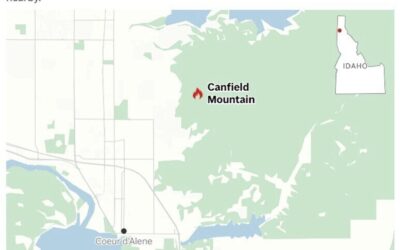Nov. 8—Efforts this week to pump more water into the burning swamp on the east edge of New Orleans are cooling the heat but may be producing more smoke, potentially contributing to the “super fog” that closed several major arterials on Wednesday morning and set off a set of accidents Tuesday.
The New Orleans Fire Department estimates that nearly a quarter of the 200-acre fire is now extinguished. Smoldering on private land near Bayou Sauvage Urban Wildlife Refuge, the fire has produced noxious smoke across the New Orleans area since Oct. 14.
On Monday, the Army Corps of Engineers lent out five portable pumps to bolster the two the Sewerage & Water Board has been using since Oct. 19 to try to flood the swamp with water from a nearby drainage canal. There are no nearby hydrants.
“The added water is helping,” NOFD Deputy Superintendent Roman Nelson said Wednesday morning. “The ground absorbs so much water so it’s hard to gauge how affective it is, but we think it’s about 20% out.”
He’s not sure when the smoke will cease.
If the air seemed smokier on Wednesday, the added water might be the culprit.
“As you put water on some areas, you do experience more smoke coming up,” Nelson said.
The smoke combined with dense fog to shroud roads in New Orleans East, causing at least four hours of traffic congestion and school delays on Wednesday.
The smoke and fog have caused two deadly incidents in the New Orleans area in recent weeks. On Tuesday, a man was killed and eight other people were injured during vehicle crashes during a super fog. Late last month, the smoke and fog combination resulted in a 158-vehicle pile-up on Interstate 55 in Manchac that left seven people dead and dozens injured.
Complaints about the smoke have increased, with some New Orleanians reporting eye and nose irritation, nausea and respiratory illnesses. The city is offering face masks at some libraries and recreation centers. Health officials have urged people in the smoke’s path to go indoors, especially if they are young, elderly or have medical conditions that could be exacerbated by smoke inhalation.
Wednesday’s fog may have trapped and held the swamp fire smoke, Nelson said.
“It’s hard to tell, but fog does tend to hold smoke down,” he said. “It could be the fog is containing the smoke.”
The fire is burning in the swamp’s dense, boggy soil, known as peat. Similar to coal, peat can smolder for weeks or months and release a harsh smoke that smells similar to burning plastic.
A similar fire that burned last month on National Park Service-owned swampland in Jean Lafitte was met with a faster, stronger response. Multi-agency wildland firefighting crews tackled the burning soil directly using hand tools, aerial water drops and portable sprinklers. The firefighters, many of whom work for the park service and other federal agencies, churned the soil, exposing it to air and water. The Lafitte fire stopped smoking last week.
The NOFD lacks personnel with wildland firefighting training and wildfire fighting equipment. Taking a largely hands-off approach to the New Orleans East fire, NOFD has mostly relied on water pumps to flood the fire zone. The first pumps were put in use nearly a week after the fire was first reported.
The state Department of Agriculture and Forestry has sent bulldozers to dig trenches to contain the fire, but has opted not to send in its wildland firefighters, noting that they are not deployed at wetland fires. The agency recently began using its dozers to dig ditches in the swamp’s interior to help distribute floodwaters, according to the NOFD.
While some public officials have said the fire is burning in a marsh, the environment is actually a swamp, according to wetland scientists. Marshes and swamps are both wetlands, but a marsh is a treeless landscape akin to a prairie. A swamp is wetland dominated by trees, making it more like a forest.
The land burning in New Orleans East is dominated by a mixture of tallow, willow, oak and hackberry trees. Many of the watery patches among the trees have shriveled after months of drought. This has allowed the peat to dry and heat up, potentially causing it to self-combust.
Nelson said the city may have to handle similar fires in the future as the climate changes, making for hotter, drier summers and more fires in landscapes that once stayed soaked year-road.
“It’s something we may have to prepare for as we see more fires like these,” he said.
___
(c)2023 The Times-Picayune | The New Orleans Advocate
Visit The Times-Picayune | The New Orleans Advocate at www.nola.com
Distributed by Tribune Content Agency, LLC.




